How to Level Up Your In-store Experience With Electronic Signage
Take a moment to answer this question: What’s the most memorable piece of marketing you’ve seen out in the world recently?
If your answer includes a digital sign of some sort, you’re not alone. Electronic signage is everywhere, and it does everything from promoting products and services to helping people find their way or delighting them at the cash register (let’s be real: We all love loyalty rewards).
The dynamic nature of electronic signage and the functionality it makes possible are helping small business (SMB) retailers of all types level up their in-store experiences. In fact, a 2021 Software Advice survey of retail business owners and managers shows that an overwhelming majority (86%) of respondents have already adopted digital in-store technology or plan to.
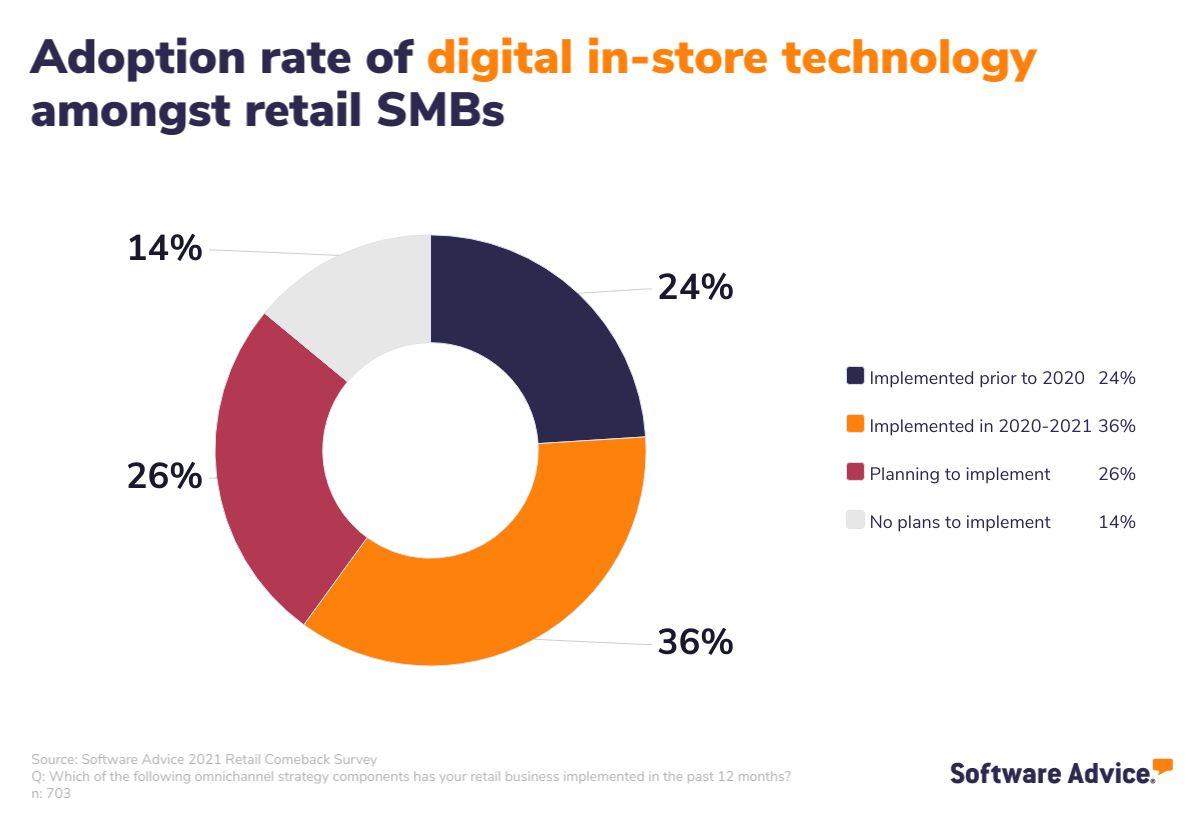
If you’re part of the remaining 14% not taking advantage of this growing wave of marketing magic, we have one more question for you: Why not? Your competitors certainly are, and implementing digital signage in any way that’s less than well-thought-out and strategic will leave you trailing in their wake.
This guide offers a step-by-step process for implementing your own electronic signage strategy to enrich your in-store experience and attract new customers. You’ll learn how to decide what type of signage to use and get some pointers on creating content and measuring the results of your efforts. But before we dive into the steps, let’s define electronic signage at face value.
What is electronic signage?
Electronic signage, also known as retail digital signage, refers to applications that disseminate dynamic media content to displays or monitors on the sales floor of a retail store. This type of media can include interactive elements and is also sometimes referred to as narrowcasting.
The reason this is so important is—even in the era of click and collect, online ordering, and virtual experiences—in-store shopping still takes the crown as the top sales channel for many small businesses.
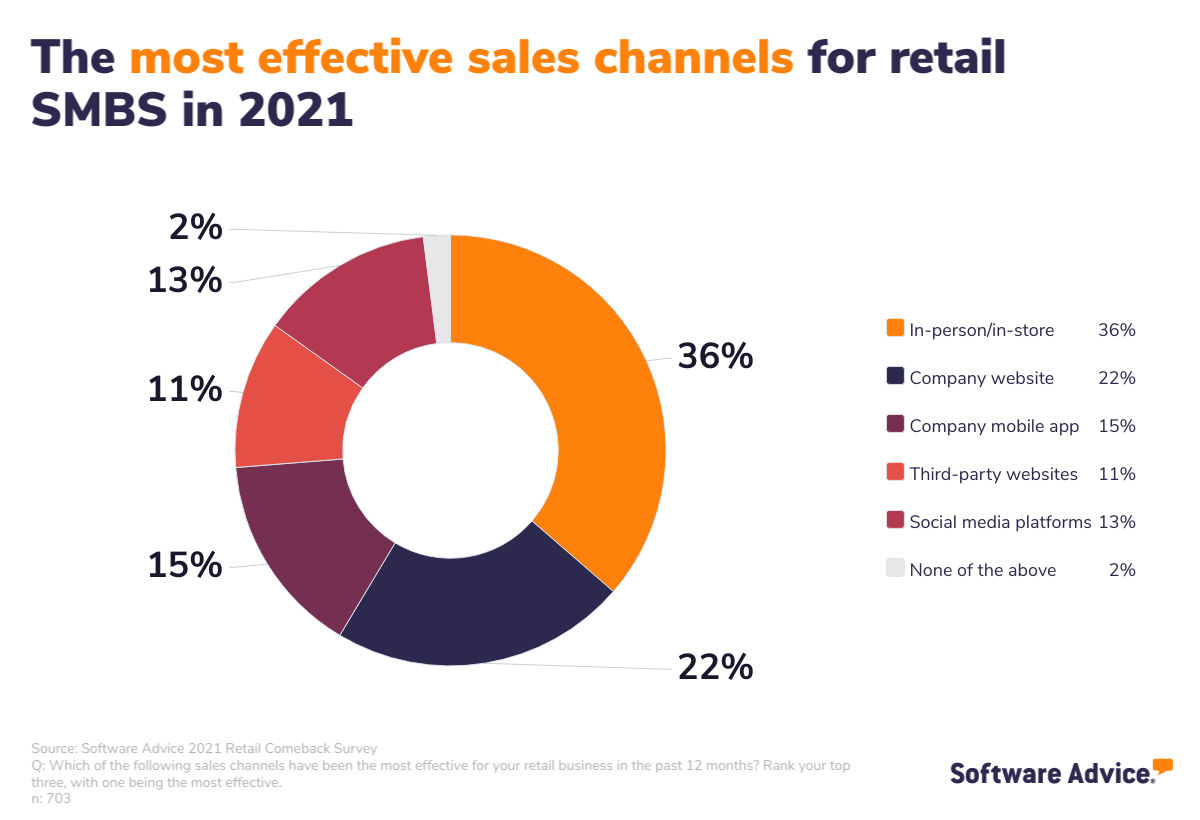
In the same 2021 survey, Software Advice found that 36% of respondents ranked in-person shopping as their most effective sales channel overall. A further 29% ranked it as the second most important which makes it clear just how important the in-store experience is for your bottom line.
Step 1: Determine your goals
The first step in any process meant to implement new technology at your small business should be to determine your goals.
Are you simply advertising your products and services in a new way?
Do you want to create urgency around in-store specials?
Is the idea to inform or entertain customers, or to create a more pleasant in-store experience?
Are you hoping to modernize your store to attract new customers?
Asking yourself questions like these will help you set goals that can be tracked and also help determine what type of electronic signage you should be taking advantage of.
Getting started
Make a list of what you’re doing well in store and what you feel you could be doing better. If you want to attract new customers, consider ad placements at the entrance with dynamic content to draw people in. If you want to delight your existing customers, think about implementing a loyalty program that offers rewards for repeat purchases.
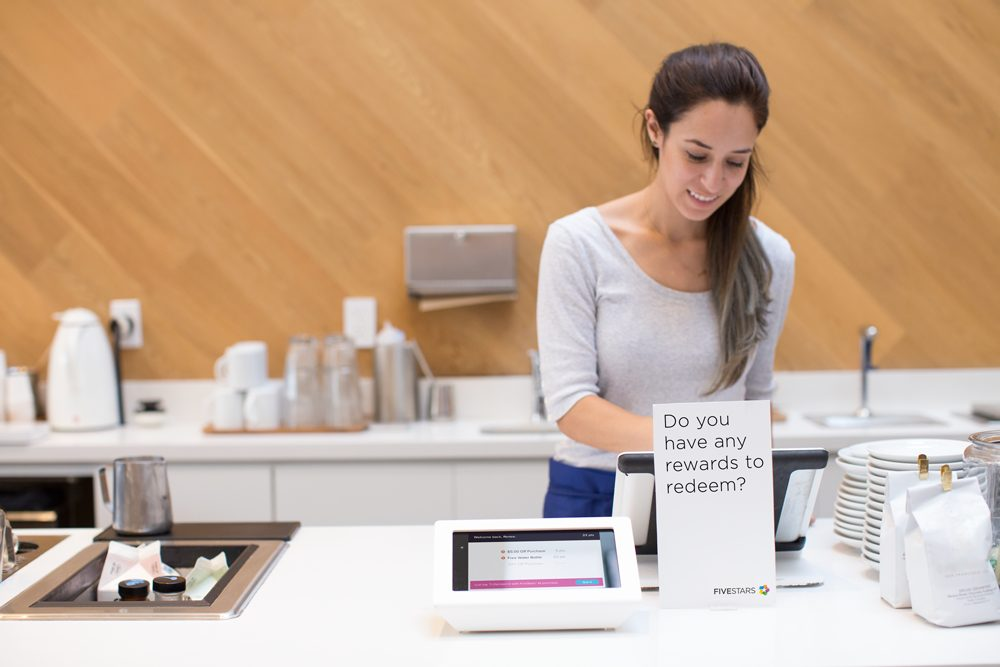
An example of a reward redemption tablet at the register from FiveStars Software (Source)
Step 2: Decide which types of electronic signage you’ll use
After you determine what you’d like to accomplish with the addition of digital signage, it’s time to select which types of digital signage will help you get there. Things like interactive wayfinding applications, digital menu boards, a video wall, or media players can all sound enticing, but it’s important to narrow down your options based on your budget and desired functionality.
It can be tempting to try and implement multiple tactics at once. Onboarding even one digital signage solution can be costly, so make sure the one you start with has a chance to create an outsized impact. To help you do that, let’s go over some of the common digital signage applications below and who they’re best suited for.
Digital menu boards/menu board: Perhaps the most common use of electronic signage is the digital menu board. Found in places like restaurants, cafes, and service-based businesses like salons, digital menu boards offer flexibility that can’t be matched by traditional menus.
Media player(s): Narrowcasting video content to media players throughout the store is a common and effective use of electronic signage. These work well for any business that wants to add dynamic content to their in-store experience in the simplest way possible.
Interactive wayfinding: Interactive maps and directories are best used in larger businesses that have multiple sections or levels. These can be fully interactive with touch capabilities or merely display map information.
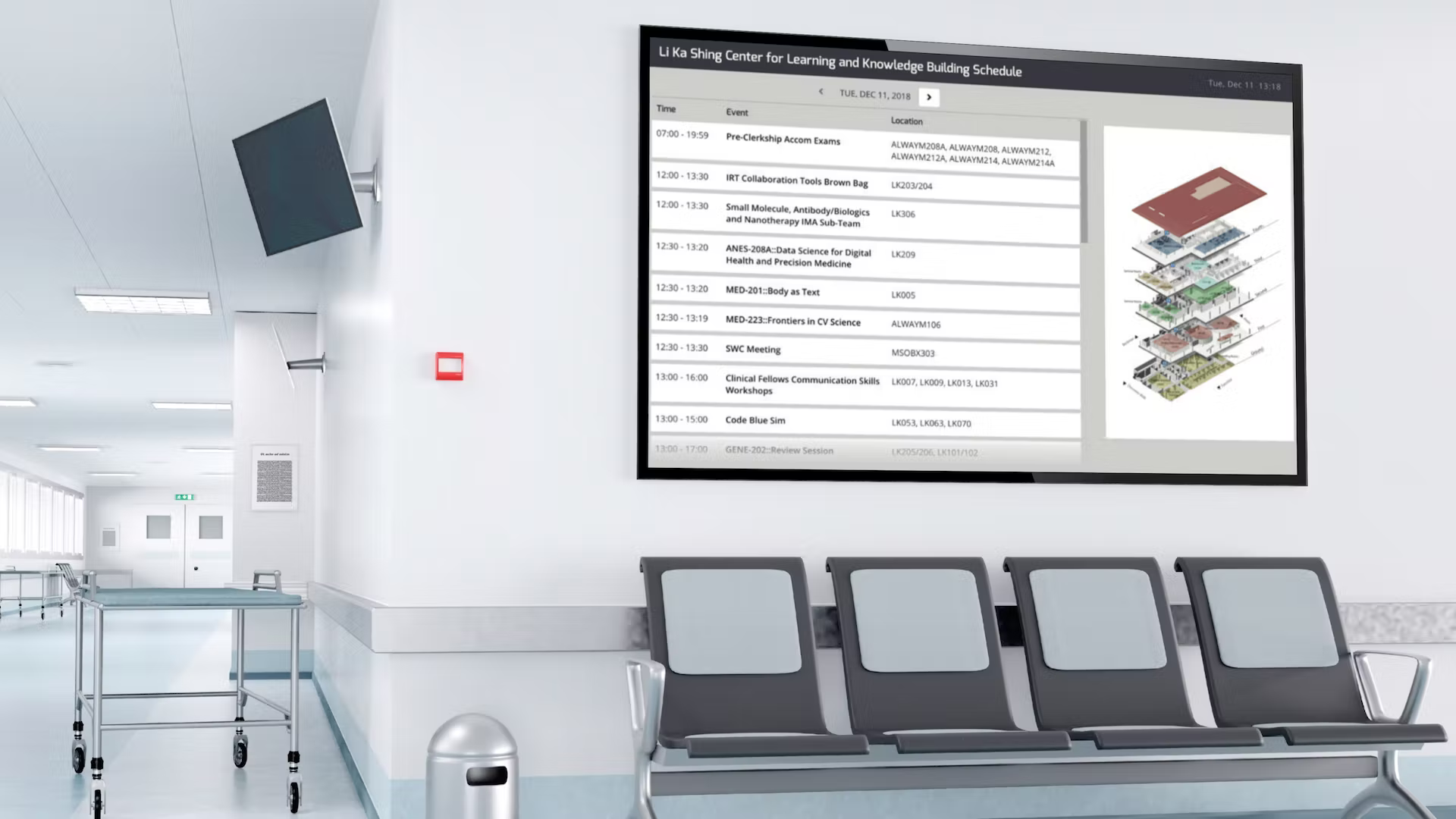
An example of interactive wayfinding in action from TelemetryTV (Source)
Getting started
Start small by choosing one method to implement (at first). Digital menu boards, narrowcasting to media players, and loyalty programs are easy to set up and enrich the customer experience by adding dynamic media or—in the case of loyalty rewards—offering a compelling reason for customers to return.
Step 3: Develop your content
After you’ve determined what type of electronic signage you’ll utilize, it’s time to develop the content you’ll be displaying on it. Whether you have an in-house marketing person or outsource content like this to a third party, it’s important to make sure whatever you produce aligns with your brand in the best way possible.
This means consistent brand imagery and fonts, having your logo displayed prominently where applicable, and leaning on original photography when you can.
Tailoring your content to the display method you choose will also serve to create a more professional look. For example, you wouldn’t want portrait style photos with unsightly negative space on either side if you’re using widescreen TVs. It’s also best to avoid generic or stock imagery if you have the ability to use your own product photography.
Getting started
Take advantage of digital signage software to easily create, edit, and disseminate images across your in-store devices. Many solutions include templates and cloud-based editing functionality to make this process even easier with the limited resources of a small business.
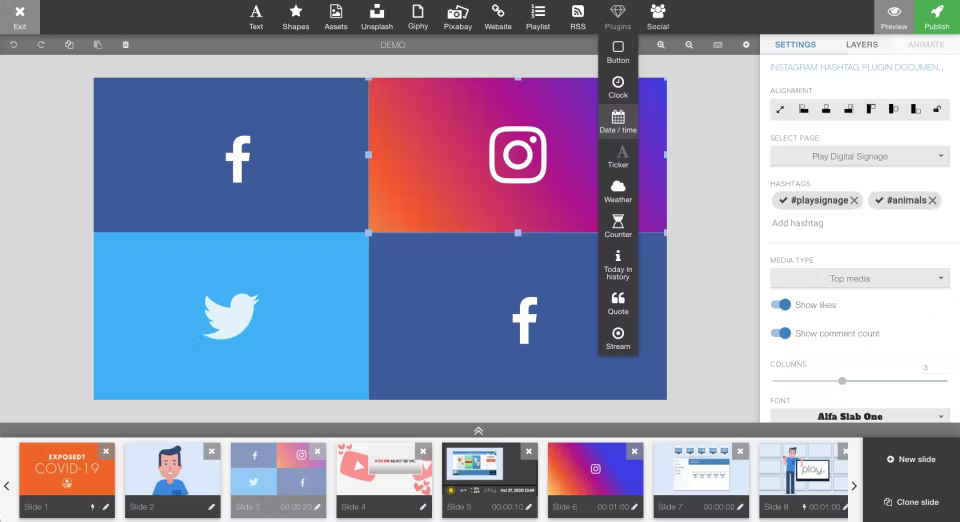
An example of cloud-based editing functionality from Play Digital (Source)
Step 4: Deploy your new strategy
Once you’ve decided on some goals for your new technology, chosen the right types of digital signage to employ, and created your brand’s content to display, you’re ready to usher your in-store experience into a new era!
Now’s the time to get into the nuts and bolts of how you’ll deploy your chosen methods. Ask yourself questions like:
How many pieces of equipment do I need (such as monitors, TVs, tablets for loyalty programs, etc.)?
Do I need the help of digital signage software to manage my content?
If so, who’s responsible for managing the software?
What types of rewards will I offer for my loyalty program?
What, if anything, is required on a daily basis to keep my new system running?
Answering questions like these will help you get a better idea of the practical implications of your digital signage strategy. It will also help you determine any necessary preparations to make before you launch.
Getting started
Answer the questions above! Once you finish that list (along with any other questions you come up with) you’ll have nailed down the hardware, software, personnel, and logistical info you need to hit the ground running with a new digital signage solution.
What’s next? Enjoy the fruits of your labor with an eye for the future
Electronic signage is being adopted at a rapid pace to meet the demands of shoppers returning to in-store experiences. Small business owners in a variety of industries are leaning on this technology to delight their customers, and with this guide in your toolbox now you can too.
Being thoughtful about choosing the right electronic signage solutions to implement, creating content that will engage your customers, and doing these things with specific, measurable goals in mind will attract new people to your brand and help usher your business into an increasingly digital era.
If you’re eager to hear more about the ever-evolving world of digital marketing, visit our Research & Articles page where we share new resources and insights daily. Here’s some more reading on the growing trend of digital display advertising to get you started:
Methodology
Software Advice conducted this survey in June 2021 of 703 retailers to learn more how they’ve pivoted their businesses in the area of fulfillment and alternative payment models. Respondents were screened to confirm full or part-time employment in the retail or restaurant industries for businesses with both a physical and ecommerce location. Respondents were also screened for a role as executive, president, director, founder or equivalent role.
Note: The applications selected in this article are examples to show a feature in context and are not intended as endorsements or recommendations. They have been obtained from sources believed to be reliable at the time of publication.